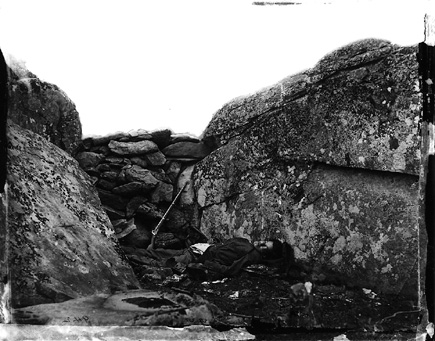Alexander Gardner
History Made, History Recorded
Gardner had gotten the telegram from the War Department the day before at his Manhattan brownstone. It said that John Wilkes Booth, who had been at large for 12 days after killing Lincoln, had himself been shot and killed at Garrett's farm in Virginia. The Secretary of War, Edwin Stanton, who was in charge of the Lincoln murder investigation, requested that Gardner proceed to the Navy Yard on the morrow to photograph the conspirators who were being held captive there.

The Conspiracy
Like most Americans, Gardner had read in the newspapers of the Confederate conspiracy
Booth inspired. His brilliant idea was to assassinate, in one night, the President,
Vice President, and Secretary of State, the upper echelon of the Executive Branch.
With no one to lead it, the Executive would fall and with it the Republic.
On April 14, 1865, at the evening performance of Our American Cousin at Ford's
Theater, Booth himself shot Lincoln. Then things began to really go wrong. Booth's
escape was interrupted momentarily by a broken ankle suffered upon a leap to
the stage.
George Atzerodt, who was supposed to kill Vice President Andrew Johnson, could
not go through with it. Lewis Paine, meanwhile, broke into Secretary of State
William Seward's home and tried to cut his throat but failed. Seward had
had a carriage accident and wore a protective leather neck brace. Paine had
to settle for a panicked slice of Seward's face. Escaping into the night,
Paine was captured soon after, as were all the conspirators.

It was Stanton who had ordered the conspirators to wear canvas hoods that covered
their heads and faces. Besides Paine and Atzerodt, there was Davy Herold, Michael
O'Laughlen, Samuel Arnold, and Edman Spangler. They were held in shackles
aboard the ironclad vessels Montauk and Saugus. The ironclads were unwieldy
iron rafts meant only for coastline duty since they were too heavy to plow the
open seas.
Deep in the bowels of the Montauk, Paine struggled with his shackles and his
thoughts. It was there, in that dark, dank hole that Gardner produced what some
consider his greatest work.
 The
Photographer's Story
The
Photographer's Story
Alexander Gardner was born in Glasgow, Scotland, in 1821. By adulthood, he had
become a committed socialist. In 1850 at the age of 29, Gardner, his brother
James, and seven others of his group crossed the Atlantic. Arriving in New York,
they went west to Clayton County, Iowa, where they built a cooperative socialist
community. Gardner soon returned home to fund raise and recruit new members.
And then, as happens so many times in the lives of young artists, fate took
a hand.
In May, 1851, Gardner visited the Great Exhibition in Hyde Park, a celebration
of contemporary technology where he saw the photographs of Mathew Brady. It
was a transformative moment. Soon afterward, Gardner, who had always been interested
in chemistry, began experimenting with photography. He also began reviewing
photographic exhibitions for the Glasgow Sentinel.
In the spring of 1856, Gardner came to America again, this time for good. With
him was his wife, two children, and his mother. Some of his family was tubercular,
requiring expensive medical treatment. Abandoning his socialist ideals for the
practical requirement of making a living, Gardner and family settled in New
York City, where he quickly got a job as a photographer with Brady. That's
where he made his initial reputation as a master printer of collodion.
































